Loa Logitech
S315i
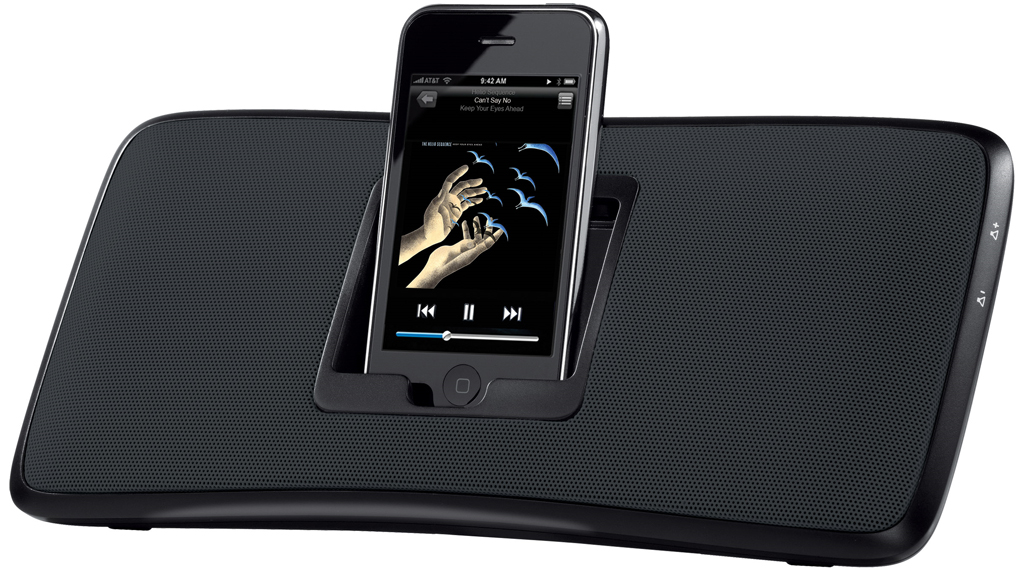
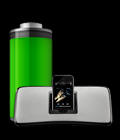
Rechargeable
You can listen to your music for up to 20 hours without a power cord in sight using Power-saving mode.
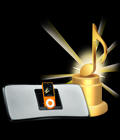
Custom-tuned speakers
It accurately reproduces your music with enhanced bass for high
highs and deep, rich lows—just how your music was meant to
sound.Watt? Learn more about audio terminology and what it means for
you.

iPhone™ and iPod® compatible
You can play and charge your iPhone™ or any iPod® model with
a dock connector.
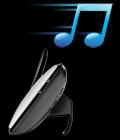
Slender, portable design
The compact, rechargeable design makes it easy for you to take to picnics, parties, the backyard, or room to room.
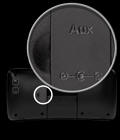
Auxiliary input
A standard 3.5 mm stereo jack opens up your music possibilities to just about any portable music player or computer.
Up to 20 hours of music from your iPod® or iPhone™—at home
or on the go.

The beat goes on
A mobile music marathon—this portable speaker lets you listen to up to 20 hours of music wherever you go.

From low to high
You’ll hear every note the way it was meant to be heard—with high highs and low lows.

Ready to dock
Whether you’ve got a new iPhone™or an original iPod®, you can play and charge it with this speaker.

A rechargeable speaker that lets you enjoy up to
20 hours of accurately-reproduced music from your iPod® or
iPhone™—at home or on the go.

Rechargeable
You can listen to your music for up to 20 hours without a power cord in sight using Power-saving mode.
Custom-tuned speakers
It accurately reproduces your music with enhanced bass for high highs and deep, rich lows—just how your music was meant to sound.Watt? Learn more about audio terminology and what it means for you.

iPhone™ and iPod® compatible
You can play and charge your iPhone™ or any iPod® model with a dock connector.

Slender, portable design
The compact, rechargeable design makes it easy for you to take to picnics, parties, the backyard, or room to room.
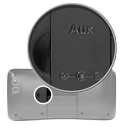
Auxiliary input
A standard 3.5 mm stereo jack opens up your music possibilities to just about any portable music player or computer.
Audio Glossary
2.0 speaker system
Your basic setup—two speakers, or satellites, that give you
stereo sound with limited bass. These easy-to-install systems
don’t include a subwoofer and are compatible with most standard
PC soundcards.
2.1 speaker system
A sound system that shakes some life into your audio. It has
two satellites, like a 2.0 system—but adds a subwoofer to give
you a more robust sound with deeper bass. It’s just as easy to
set up as a 2.0 system, but the subwoofer takes up additional
space.
24-bit DAC
24-bit digital
5.1 digital decoding
5.1 speaker system
A surround sound system with speakers in front of and behind
you to immerse you in your entertainment. It includes left and
right front speakers, left and right rear speakers, a front
center speaker, and a subwoofer. If you’re into movies or
gaming, this is the perfect choice for you.
360-degree sound
Balanced sound no matter where you are in the room. This is
created by using both forward- and backward-firing drivers that
project sound evenly in all directions. Also known as
omnidirectional acoustics.
24/48 kHz encoding
6-channel direct
An input with three separate stereo mini-plug jacks (1/8
inch) that connects to PC sound cards, or can be used as three
separate stereo inputs for use with headphones, iPods, or other
devices with an 1/8-inch jack or plug.
96/24 decoding
An enhanced, higher-resolution, studio-quality format
available on many DVD video and DVD audio discs. Refers to
24-bit, 96 kHz audio.
A
AAC (Advanced Audio Coding)
A successor to MP3. It’s an audio codec or device that
decodes or encodes digital data. It offers higher sound quality
at lower bit rates than MP3. It’s also known as MPEG-4 AAC.
Active driver
The main driver, or electromagnetic component, of a speaker.
This is what makes the sound. See driver.
Amplifier (Amp)
A device that increases signal level. They typically increase
voltage, current, or both.
Analog signal
A continuous electrical signal that’s commonly represented as
an oscillating wave. It can take any value in a range and
changes smoothly between values, as opposed to digital signals,
which are characterized by discrete bits of information in
numerical steps.
Apple Lossless
An audio codec, or device that decodes or encodes digital
data, developed by Apple Inc. This is a lossless method of data
compression for digital music. See lossless.
B
Bass
The low end of the sound spectrum that goes from 20 Hz to 200
Hz. It puts the boom, shake, and rumble into your entertainment.
This is the range for explosions, tubas, cellos, bass, drums,
and more. Also known as low range.
C
Center channel
The center speaker in a surround sound system. It goes below
or on top of your monitor or TV and produces the dialog and
vocals—making them seem like they’re coming right out the
screen.
Clipping
A severe form of distortion that occurs when you overload an
amplifier. It makes the sound hard and edgy.
D
DAC (Digital to audio converter)
A device that converts a digital bit stream to an analog
signal so your speakers can turn it into sound.
dBs (Decibels)
A unit of measure of the relative loudness of sound. The
threshold of hearing is 0 dB. A whisper is 15-25 db. A normal
speaking voice is 65-70 dB. Live rock music is 120 dB and up.
And a jet aircraft is about 140-180 dB. Anything over 140 dB
hurts to listen to and can damage your hearing.
Dead zone
An area of the room with quieter sound from your speakers due
to sound waves cancelling each other out.
Digital signal
An audio signal that is usually represented by ones and
zeros. A digital signal has to be converted to an analog signal
before it can be turned into sound.
Digital rights management (DRM)
A technology that allows content owners to determine and
control how you can enjoy content. That can include how many
copies you can make of a song or what types of devices you can
transfer it to.
Distortion
Anything that alters the musical signal from its original
quality.
Dolby® digital
A five-channel audio format consisting of left, center, and
right front channels, left and right rear channels, and one
channel for the subwoofer. It’s one of several systems used for
surround sound. All processing is done in digitally for your
listening pleasure.
Down-firing subwoofer
A subwoofer that has its cone facing down—directing bass
throughout the room.
Driver
This is where the magic happens. It’s an electromagnetic
device that turns electrical signals into sound waves in the air
by moving a thin layer of fabric or paper. It’s usually made up
of a magnet and voice coil.
DTS™
DTS decoders are in virtually every major brand of
5.1-channel surround processor.
E
Equalization (EQ)
The purposeful changing of the frequency response of a
circuit to change the sound. You might do this to boost the bass
for gaming or movies. Or to create a more balanced sound for
your music.
F
FLAC (Free Lossless Audio Codec)
A type of lossless audio compression. It doesn’t remove any
information from the audio stream like lossy codecs such as MP3
and AAC. That makes it a good choice for archiving audio
collections as well as everyday playback. See Lossless, Lossy.
Frequency
One measure of a sound wave. Unless you’re superhuman, the
range for hearing is about 20-20,000 Hz (20 Hz-20 kHz). Lower
numbers represent lower frequencies
Frequency Directed Dual Drivers
A Logitech® technology that uses two identical full-range
drivers in each satellite. A special filter that detects
specific frequencies is applied to one of the drivers—gradually
muting specific frequencies in that driver as needed to prevent
hot spots or dead zones in the soundfield. The result is better
sound quality throughout the entire frequency range of the
speaker.
Frequency response
The range of frequencies an audio device can reproduce.
Full-range drivers
A driver designed to reproduce most of the sound spectrum.
H
Hertz (Hz)
The standard unit of frequency, equal to 1 cycle per second.
One hertz (Hz) represents one cycle per second, 20Hz represents
20 cycles per second, and so on.
High-excursion drivers
High-resolution encoding
High range (highs)
The high end of the sound spectrum, also known as treble. The
high range goes from 4,000 Hz to 20,000 Hz. It covers stuff like
bells, cymbals, and the highest notes on a piano.
Hot spots
An area of the room where there volume gets too loud because
the sound waves are amplified.
I
Impedance
A measure of electrical resistance specified in ohms.
J
Jitter
A tendency toward poor signal synchronization caused by
electrical changes. It can cause doubling up or skipping of
portions of audio.
L
Long-throw subwoofer
A subwoofer that gives you higher sound levels at greater
distances.
Lossless
A class of data compression that allows the exact original
data to be reconstructed from the compressed data.
Lossy
A class of data compression that doesn’t allow the exact
original data to be reconstructed from the compressed data.
Low range (lows)
See bass
M
Matched quad micro-drivers
A set of four identical micro-drivers, offering powerful
sound in a compact design.
Max-X™ drivers
High-excursion drivers that allow for greater dynamic range,
improved bass, and lower distortion.
Midrange (mids)
The middle frequencies of sound from 200 Hz to 4,000 Hz. This
is the range of sound our ears are most sensitive to and
includes most vocals (not the glass-breaking kind) and
instruments.
Midwoofer
A driver that produces mid and some low frequencies.
MP3
A popular digital audio encoding and lossy compression
format. It greatly reduces the amount of data (10:1 compression)
needed to represent audio. See Lossy.
Muddy
Sound that is poorly defined, sloppy, or vague.
N
Network music player
A device that wirelessly streams the digital music stored on
your computer, Internet radio broadcasts, and tracks from online
music services to any room of your home. You can choose a player
that connects to your stereo or powered speakers, or an
all-in-one solution that has its own speakers.
Neodymium micro-drivers
Small drivers made from a rare earth metal that is the
strongest permanent magnet on earth.
Noise
Unwanted sound or distortion.
Noise isolation
Preventing outside sounds from entering the ear when you’re
listening to music with earphones. It lets you hear your music
and not the chatty person behind you.
O
Ogg
A type of file format.
Ohm
A unit of electrical resistance or impedance presented by the
speakers and recognized by the amplifier. See Impedance.
Omnidirectional acoustics
See 360-degree sound.
P
Passive crossover
A filter that splits the audio signal into separate
bandwidths so each segment can go to the correct type of driver.
It keeps the lows from mingling with the highs in your tweeter,
for example. This type of filter is made of passive components.
Peak power
The maximum wattage an amplifier can deliver as a brief burst
during a musical peak. This is not an accurate measure of power.
RMS power, which is standardized, should be used when you
compare speakers instead.
Phase-plug design
Port
An opening in a speaker cabinet that increases the bass
response of the speaker.
Ported enclosure or ported subwoofer
A type of speaker enclosure that uses a port to improve
efficiency at low frequencies.
Pressure drivers
A driver that creates pressure inside a speaker cabinet that
is sealed and airtight to move the passive radiator, increasing
sound levels. This is an efficient way to create tighter, lower
bass.
R
Real-time bass equalization
RMS (root mean square)
A standard amplifier measurement. It’s a conventional way to
measure the effective average value of an audio signal or other
power (AC) voltage.
RMS power
The amount of continuous power, measured in watts, that an
amplifier can produce. The higher the RMS figure, the louder and
cleaner music sounds. This measurement is far more accurate than
peak power.
S
Satellites
A small speaker with limited bass response.
Shielded
A design that prevents the magnet from causing interference
with other electronics.
Signal-to-noise ratio (SNR)
A specification that describes how much noise an audio
component has compared to the music signal.
Sound pressure level (SPL)
A measure of the loudness of a sound, relative to the
threshold of hearing, measured in dB (decibels). It generally
goes from 0 to 140 dB. 140 dB is considered painful and can
damage your ears.
Soundstage
The perception of where the different instruments and vocals
are located on an imaginary stage.
Stereo
The illusion of a continuous soundfield spread around the
listener by two or more related audio signals. It’s often used
to indicate that there are two channels.
Stereo XL
A Logitech® technology that widens the soundstage beyond the
physical boundaries of the speakers, creating an immersive audio
experience.
Subwoofer
A speaker designed to reproduce very low frequencies (20-200
Hz).
Super regulator
Surround sound
Multi-channel audio playback that creates a three-dimensional
sound that immerses you in your entertainment. It’s typically
used for movies and gaming and makes you feel like you’re part
of the action.
T
THX®
A series of specifications for surround sound systems.
They’re designed to ensure that the sound of movies is as close
as possible to what the filmmakers intended.
Top-fire armature
A custom in-ear speaker design—featured in the Ultimate Ears®
SuperFi 5 and 5vi earphones—that uses a compact wideband driver
to create a high-performance sound.
Treble
See high range.
Tri-amplification
A design in which each driver (woofer, midrange, and tweeter)
has their own amplifier. This generally results in a better
sound because the signals can be tailored for the driver more
accurately before they get to the amplifier.
Tweeter
A small, lightweight driver for reproducing the highest
musical frequencies such as violins and cymbals, and typically
everything above 2,000 Hz.
Two-way speaker
A speaker with two different drivers that are dedicated to
different frequency ranges.
V
Virtual surround sound
Technology that provides a rich surround sound experience
with just two speakers by down-mixing Dolby Digital 5.1 channel
and Dolby Surround (Pro Logic) to 2-channel audio.
W
WAV (or WAVE)
A Microsoft and IBM audio file format standard for storing
audio on PCs.
Watts
A power measurement derived by multiplying current by
voltage. It’s used to quantify an amplifier’s power output.
WMA (Windows Media Audio)
A proprietary compressed audio file format developed by
Microsoft.
WMA Lossless
A lossless compressed audio file format developed by
Microsoft. See lossless.
Woofer
A driver that reproduces bass frequencies. It can be used in
a subwoofer or a two-way or three-way speaker.
System Requirements
-
- Supports iPhone™ and all iPod® models with dock connector
- Uses the Apple Universal Dock specification
- Supports other portable music players via 3.5 mm auxiliary input
iPod and/or iPhone not included. iPod and iPhone are trademarks of Apple Inc.
Warranty Information
- 1-year limited hardware warranty
Package Contents
Logitech® Rechargeable Speaker S315i100-240v Power supply
Quick-start guide
